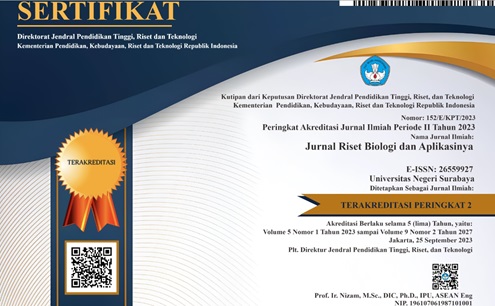Sex Determination of Sea Cucumber Acaudina rosettis from Madura Straits, Indonesia
DOI:
https://doi.org/10.26740/jrba.v4n2.p83-89Keywords:
Acaudina rosettis, sex determination, gonads, Madura Straits Sea cucumber, sexAbstract
Acaudina rosettis is one of the commercial sea cucumber species that is widely consumed on the east coast of Surabaya, East Java, Indonesia. Although its abundance in nature has begun to show signs of decreasing, studies on this species are still very limited. This study aimed to examine indicators that can be used to determine the sex of A. rosettis individuals. Acaudina rosettis samples were collected from Madura strait in the mid of Hijri month for three months. The sea cucumber samples were then dissected. Body wall without viscera and gonads was weighed. The gonads were then characterized macroscopically and microscopically, prepared into histological slides with hematoxylin-eosin staining. The results showed that A. rosettis samples could be classified into three sex groups based on the type of gamete cells observed in the tubules; male (spermatogenic), female (oogenic), and undetermined sex (no gamete cells found). Gonads had three colors; yellow, pink, and orange and were in five stages of reproductive phase; gametogenesis (G), mature (M), spawning (S), and post-spawning (PS). Male samples had yellow and orange gonads, female samples were pink and orange, and all undetermined sex were orange. The G gonads were yellow and orange, M were yellow and pink, while S and PS were orange. Body wall and gonad weight at the same reproductive phase did not show any difference between males and females. Based on the results, gonad color can be used as an indicator of sex determination, but only in G and M reproductive phases.
References
Gao, F., Xu, Q., Fei, G., Qiang, X. U., & Yang, H. (2011). Seasonal biochemical changes in composition of body wall tissues of sea cucumber Apostichopus japonicus. Chinese Journal of Oceanology and Limnology, 29(2), 252-260. https://doi.org/10.1007/s00343-011-0041-7
Hamel, J-F. & Mercier, A. (1996). Studies on the reproductive biology of the Atlantic Sea cucumber Cucumaria Frondosa. SPC Beche-de-mer Information Bulletin, 8
Rasolofonirina, R., Vaitilingon, D., Eeckhaut, I., & Jangoux, M. (2007). Reproductive cycle of edible echinoderms from the Southwestern Indian Ocean, II: The sandfish Holothuria scabra (Jaeger, 1833). Western Indian Ocean Journal of Marine Science, 4(1), 61-75. https://doi.org/10.4314/wiojms.v4i1.28474
Widianingsih, W., Zaenuri, M., Anggoro, S., Kusumaningrum, H. P., & Hartati, R. (2018). Preliminary study on gonad maturity stages of the sea cucumber Paracaudina australis from Kenjeran Water, Surabaya, Indonesia. IOP Conference Series: Earth and Environmental Science, 116(1), 12035. https://doi.org/10.1088/1755-1315/116/1/012035
Winarni, D., Khaleyla, F., Damayanti, H., Nugraha, Y.F., Utami, C.S., Oktafiani, D., Lestari, L.I., Darmanto, W. & Hayati, A. (2015). Reproductive peak, gonadal cycle, and gametogenic cells determination of sea cucumber Paracaudina australis from Madura strait, East Java, Indonesia. International Journal of Academic Reesearch 7, 112-115
Downloads
Published
How to Cite
Issue
Section
License
Copyright (c) 2022 Jurnal Riset Biologi dan Aplikasinya

This work is licensed under a Creative Commons Attribution-NonCommercial 4.0 International License.
 Abstract views: 3175
,
Abstract views: 3175
, PDF Downloads: 443
PDF Downloads: 443












